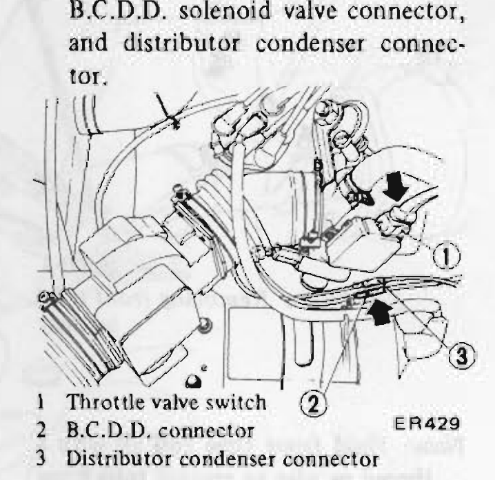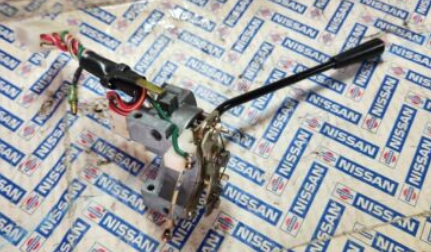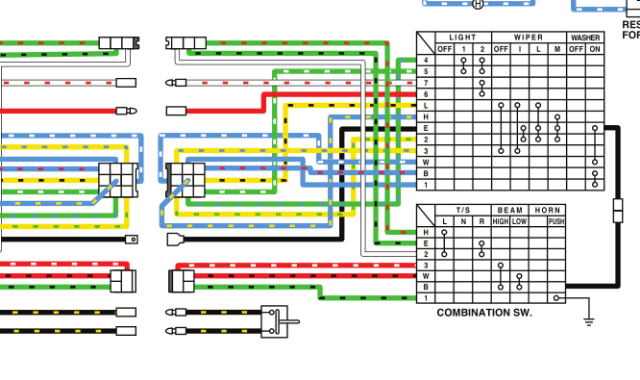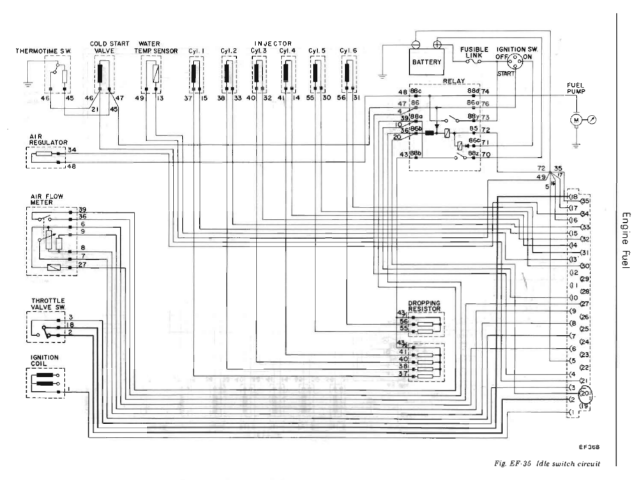
NewZed
-
Posts
6625 -
Joined
-
Last visited
-
Days Won
60
Content Type
Profiles
Forums
Blogs
Events
Gallery
Downloads
Store
Posts posted by NewZed
-
-
The Jenvey ITB system won't use the AFM. The carbon canister is at the end of the fuel tank vent. If you like the smell of raw gasoline then remove it. The distributor is part of an electronic ignition system. The only way to get rid of it would be to use a crank trigger to control spark.
You'll want to start studying up on EFI. The Jenvey system doesn't include engine management (injector and/or spark control). It's just the mechanical parts, the throttle bodies. "Deleting" can come later if you want to have an engine that runs well. Study up on the "go" while your car's in the shop for the "show". Looks like an interesting project and collection of parts. Good luck.
https://www.jenvey.co.uk/support/
-
There are many ways to get it done. Just make sure that you follow the wiring diagram. People have got their +'s and -'s mixed up and created brand new problems. Nissan didn't use red and black like they do today. The positive power supply connection looks just like the negative.
If you're putting an EFI 280Z back together you should learn how to use a multimeter and get the FSM and the 1980 EFI Guide. There will be electrical measurements to take. The 280Z is one of the best ways to learn about EFI. Today's cars are computerized but the fuel injection principles are the same as back in the 70's. The multimeter will be your best friend.
-
The part is not available anymore. You'll have to get two separate green links and make them work. The separate links are available on the various Z car sites.
What happened to the one that came with the car?
-
Look underneath that metal box your arm is lying on and you'll see the EFI relay.

-
R is red, L is blue. Looks like the EFI fusible link connection. 1978 used two green ones, spliced together. Looks like you have to buy them separately now. They connect directly to the battery positive post.

-
Here's more on locating. You might have meant this already, I'm just posting for clarity, for the discussion. There's a latency involved. Kind of complicates things for racing.
https://www.androidcentral.com/how-does-gps-work-my-phone
- advice from an amateur woodworker (the guy that wrote the article above). Don't know how deep it is. I just know that things keep changing.
-
Not an expert in race stuff, but just a short observation. GPS stands for Global Positioning System and it uses satellites. Cell phones can use triangulation from cell tower signals. I have an early Garmin GPS device that actually shows how many satellite signals have been acquired and where in the sky they are. https://www.gps.gov/
Anyway, "GPS" for phones might not be real GPS. I do know that I can get a "GPS" location on my phone even though I don't show cell service, like on a hike in the hills. But I don't know if it 's because I have a cheap cell plan but it allows GPS for Google maps using cell towers, or if it uses satellites.
And today we have Starlink. And Motorola's satellite system, the original plan for traveling portable phones for the masses, is still out there too.
-
The cowl is a high pressure area. Air will be forced through the hole when the car is moving. It will be worse when the windows are open, the faster the car goes the more air will flow.
-
What do mean by "Data Acquisition"? Things have advanced dramatically even in just the last couple of years, for "phone" apps and standalone devices. It's pretty incredible.
-
Might be the condenser on the fenderwell by the coil. It's actually more of an ignition system condenser. "Distributor" might be a translation error. The condenser would be a small silver cylinder with one wire stickling out one end. mounted to the fenderwell with a s ingle bolt (actually, by definition, a screw).

-
Nothing gets deleted. It's just a different shape, usually machined for more modern injectors. But it works exactly the same as the old one. It's just a tube that gasoline flows through.
There's no CSV supply branch on the new rail so that would be why it's gone now. The "air sensor" is probably the auxiliary air regulator. It allows air past the throttle blade to give a high idle when the engine is cold. Without it you'll have to work the throttle until the engine warms up. No reason to remove it for a new fuel rail. It's actually a convenient device. It has hoses connected to it though it probably looks like "emissions crap", removed for a clean look and more primitive engine operation.
-
On 10/10/2022 at 4:08 PM, Michael said:
upon filling say 3-4 gallons at a time, I almost invariably run out of gas after maybe at most 10 miles of driving. By “run out of gas”, I mean that the engine dies. Then, moving the carburetor throttle by hand, results in anemic or non-existing squirting into the primaries. This suggests that the carb’s fuel reservoirs are nearly empty.
Lots of guessing here. Why don't you get some actual numbers and do the math? Fill tank, drive car known number of miles, refill tank with known quantity of gas, calculate gas mileage..
-
The antenna wire/cable is about 1/4" thick.
-
The dimmer switch is actually at the base of the turn signal stalk. (I see on the internet that some people are calling the dash light dimmer the dimmer switch). If you don't see power there it could be because both headlight bulbs are blown.

-
After C3 it runs directly to the fuse block.
Here is a link to a wiring diagram. Black and white or color.
https://www.classiczcars.com/files/category/1-wiring-diagrams/
-
The red wire then runs through connector C3 (location shown in the FSM). Maybe C3 has a problem.

-
The power goes in to the switch at 7 and comes out at 6. If you're seeing voltage on 6 at the switch itself when you turn the headlights on, (position 2), but not at the fuse block, then there's a break n the red wire on its way to the fuse block. It's shown in the wiring diagram.
There is a bullet connector for the red wire right at the steering column. Maybe it's disconnected.

-
A noid light or two on the injector plugs might show something weird. If they don't pulse steadily and shortly while the engine idles that might be an indicator.
-
Try banging on the side of the ECU and/or wiggling the connector cable where it attaches to the ECU. The ECU's have a problem with broken solder joints. Some thumping or twisting can fix it for a short while. If it does, it's a clue that the ECU has problems. People have reflowed the solder joints where the connector pins attach to the PCB to fix the problem.
You might have noticed that at the end of the long list of diagnostic tests, if nothing works, "replace ECU".
If you have a fellow Z friend maybe they have a spare ECU you can borrow. That's a quick test. They all will swap, from 75-78. The differences are minor, the connections all the same. I had a collection from 75 - 78 for a while and tried them all on my 76.
-
Pin 13 at the ECU is the coolant sensor. The other side is ground. That's the quick test and it verifies that the ECU sees the sensor. The bullet connectors are oriented male and female if I recall correctly so you can only mix the two power supplies or the two ground. So really you're just choosing between two wires. Jump Pin 13 in the ECU connector to ground and see which of the two you're looking at has continuity to ground.
People often get the thermotime and the coolant sensor plugs swapped because they're both EV1. And the thermotime switch runs through the cold start valve which is right there on the top of the intake manifold. If you want to follow the wires. The other EV1 would be the coolant sensor.

-
If everything checks out okay except the pump check valve or the FPR (they often leak down rapidly too even though they control pressure just fine), then the rich mixture is more likely from the coolant temperature sensor. Might be worthwhile to do the electrical checks at the ECU connector, using the EFI guide book. or the FSM.
The pressure leak-down might have distracted you from the real problem.
-
The power comes in to the WR, passes through the switch to the red and heads on down to the fuse block. Look at at 7 and 6 on the color drawing above. So either the switch is not working, passing current/voltage, or there's a break in the red wire on its way to the fuse block. There's a path. Measure voltage along the path until you find the blockage.
-
It's a clue that the problem is not in the ECU. The next thing you might do is to disconnect the power to the injectors. Just unplug all six. Then do the same test with the fuel pump. That will pressurize the rail and injectors but there will be no power to open them If there's still a leak then you'll know it's not electrical.
If you try that you might as well disconnect the vacuum hose to the FPR. The FPR diaphragms are known to fail and fuel leaks directly in to the manifold through the vacuum hose. The fuel might not be coming from the injectors. Unplug the injectors, disconnect the FPR vacuum hose, activate the fuel pump, and see if fuel leaks from the FPR. You'll probably know something as soon as you remove the hose. It should be dry.
If it is dry and the FPR is good and pressure still leaks down then you might just have stuck injectors.
p.s. if you've had gasoline flowing in to the cylinders then your oil is probably diluted with gasoline. You should change it as soon as you solve the problem.
-
When you turn the key on the injectors get power. The power is grounded through the ECU. You either have a short circuit on one/some of the wires on the way to the ECU from the injectors or you have a bad ECU. That is how they fail sometimes by shorting the injector circuit. A simple test would be to unplug the ECU connector and turn the key on. If pressure holds then there's no short. Or disconnect all of the injectors so you don't flood the engine and use noid lights to see if the injector circuits are grounded. The lights will light if there's a short in the wires or the ECU. You can also use a simple test light or make your own test light from tail light bulb.







High pressure fuel feed
in Nissan L6 Forum
Posted · Edited by NewZed
You might start a build thread with Jenvey in the title. There's a guy on the forum, can't remember his name, who has one already up and running. Put the details of what you're starting with in the thread.
280Z's already have a high pressure fuel system. You mentioned the air flow meter so it must be EFI already, right.